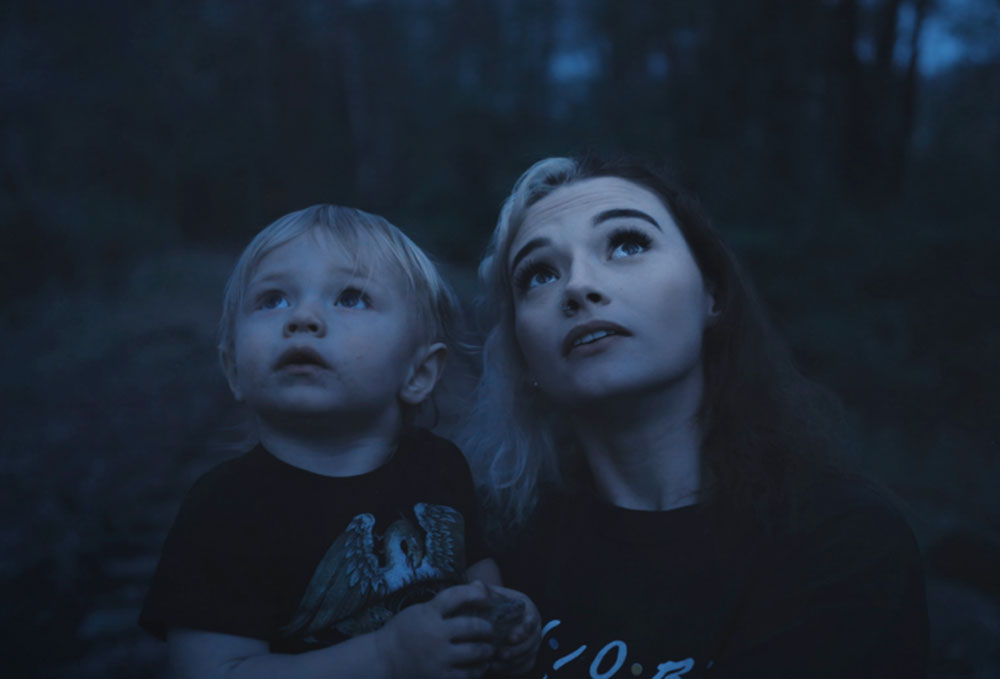There isn’t much linking Green Bank, West Virginia with the rest of the world, however the universe is another story. A sequestered area where cell phones and wi-fi have been forbidden ever since the establishment of the National Radio Astronomy Observatory, residents may lack the internet and the ability to text someone to come over, but scientists in the area are busy collecting data from the faintest murmurs they can hear coming from outer space with a giant satellite dish perched in the hills, leaving behind an unusual population that co-directors Kasper Bisgaard and Mikael Lypinski are wise to follow in “The End of Quiet.”
The Danish filmmakers bring a sharp observational eye to the small American town they cover over a period of four years, settling into a place where people have to entertain themselves when the best looking televisions are in standard definition and the community has to be one of the last remaining in the U.S. to share a public payphone. Bisgaard and Lypinski find folks of various ages finding ways to pass the time from an elderly military vet who claims to drink around 10 to 15 cups of coffee a day as he moseys around town to a grandfather who takes his granddaughter to target practice, hoping to make her as enthusiastic about the 2nd Amendment as he is, as well as a young couple that remains in the region when it’s all they can afford and a poet who moved to the area due to her electromagnetic sensitivity while her husband remains abroad.
There is a sense of isolation in what Bisgaard and Lypinski depict when not even the locals are shown to be interacting with one another, let alone the grander world, but when building in a time jump three years into the future, the two are able to chronicle what occurs when the influence of the outside starts to creep in, serving no one well when the limited trickle of information gives rise to terrifying ideas that would be disabused by a two-hour drive in any direction out of town and the contraband wi-fi leads to greater signal pollution that keeps the scientists from accomplish their aims, fearing that they’re losing out on valuable transmissions that could hold the key to discovering other lifeforms. While they face an increasing failure to connect, “The End of Quiet” does as when in spite of chronicling a community with 1990s technology, it feels as if it’s addressing completely contemporary concerns such as alienation and dependence on electronic devices.
With the film making its premiere making its premiere this week at Tribeca, Bisgaard and Lypinski graciously took the time to talk about how they first became intrigued with this most unique destination, replicating the experience of being in a place of such silence and reflecting an area that seems so distant from the world most of us live yet speaks so directly to our collective modern reality.
How did this come about?
Kasper Bisgaard: It’s one of those films that literally dropped into our hands in a bookstore. I was there checking through different kinds of photographic books and all of a sudden, I saw this gigantic [satellite] dish and I thought, “That’s interesting. People seem to be living underneath here, right? This could be an interesting idea for a film.” And then I went to Mikael with the pitch and he thought, “Well, this is interesting. We have to go. Who’s actually living here in the quiet zone?”
So we went and was like almost like going back in time before everything was wireless. It was like you’re coming into a place technologically where it’s like the 1990s, which was a strange thing to make a film where you can’t reach each other with cell phones, et cetera. It was interesting.
Was filming in such a place more difficult?
Kasper Bisgaard: It was, because if you want to have good sound, you really want to use microports, which are using radio waves, and we couldn’t use that. So back home, we had to make a special cable to connect these small microphones with a long wire to a protagonist. That was a concrete thing that we had to change before going there.
What was it like to find the five main subjects to follow?
Mikael Lypinski: We were hanging around town and talking to people, and sometimes we would see an interesting face. For example, Willard, the war veteran was one of those faces. He came in to have one of the endless coffees that he has daily, and we spotted his face, his incredible charisma, and basically asked him point blank, “can we have a little chat?” That is more or less how we approached most people. Dr. Jay Lockman from the observatory is perhaps a bit of an exception because he was an official working at the observatory, so we needed to get some permission to reach him. But once connection had been made with him, it was easy to hang out with him in town. It’s one of those places where people know each other, and often one encounter leads to another good encounter.
Kasper Bisgaard: When we were there doing our research, we spent two weeks actually talking to people and then we got a feeling of which characters and profiles we wanted to have represented. Like we wanted to have the scientist who Jay Lockman represented. We wanted to have Clover, the poet intellectual, as she describes herself, because she had come to this place because she has electric magnetic sensitivity and has to live there to avoid [cell phones]. We also wanted to have people who loves the outdoors and hunting, so we had an idea of who should represent the area.
Was the idea that this would involve a jump in time always in mind?
Kasper Bisgaard: That was movie magic. Because of COVID, we couldn’t get into the States because we’re from Europe and we were dying to get back because we thought we had some wonderful material and we just want to keep on [going]. But all of a sudden we couldn’t get back for three years, and we were anxious to get back because these people are difficult to get contact with for obvious reasons [laughs]. But when we got back, we realized that things had changed, and to some extent, Wi-Fi had slowly infiltrated the area. We thought all of a sudden, “Hey, there’s a bigger story here about a place that is slowly being eroded by modern connectivity, like Wi-Fi, cell phones, and hopefully that can reflect [people elsewhere].
Also the scientists’ feared that they’re putting so many satellites up in the sky now that the world might be polluted with radiation, which makes it difficult to get the big answers that they’re looking for [to questions like] where are we coming from? Are we alone in the universe? So it’s interesting that we might be more and more connected on the planet with cell phones, but we might even get somehow more disconnected to each other and somehow more diverted.
You mentioned special equipment for the sound and I was totally immersed in this. What was it like to recreate the experience you had on the ground sonically?
Mikael Lypinski: We were so happy to finally reach that stage of the process because that usually means that, the filming and the editing are done and now we can start to play creatively. We asked our sound designers to try to eliminate certain sounds which to them might seem necessary in order to bring out other sounds. There’s a sequence where the war veteran has his coffee in the shop and we wanted to hear him drink that coffee and not necessarily hearing too many other sounds, so we tried to make the sound design quite poetic without obviously overdoing it or drawing too much attention to it. But we were conscious of the sounds that we wanted people to hear and notice. Sometimes these sounds are loud but more often they are quite quiet. We were always more interested in the whisper than in the shouts.
One of the really interesting dynamics in this is having the voiceovers from the scientist and the poet, so you have those two poles. What was that like to piece together?
Kasper Bisgaard: During the editing process, it’s almost like the words that [the poet was] saying and also the scientist, we wanted to almost have it like a dance, like it had a rhythm and the words kind of merge while she was dancing on the porch [later in the film]. That was something that we discovered while editing and putting the sound design on. We did not realize during the filming that that’s how it was going to be. But we thought it gave this enormity. Not so much like daily life, but a feeling of bigger themes. Also the way that Mikael beautifully shot during magic hours, that was a conscious choice exactly to get that feeling of something greater and almost poetic. That was important for us.
After carrying this with you for so long, what’s it like to start sharing with the world?
Mikael Lypinski: It’s obviously super exciting. It’s been quite a wait to find the appropriate festival for this big launch and now that we are invited by Tribeca, we’re honored, We have three of our [subjects] coming in as well from West Virginia. Jay, the scientist, Kirsten, the young mother, and Dave, the gun guy and they are also super excited. They haven’t seen anything so far, so we’re hoping to have a really positive experience there in the cinema.
Kasper Bisgaard: It’s going to be really, really interesting and we’re very curious how our [subjects] feel. We are really proud of what we have done and I couldn’t be more proud to show this at Tribeca. It’s a privilege and it’s going to be a blast.
“The End of Quiet” will screen again at the Tribeca Festival on AMC 19th St. East 6 on June 11th at 6 pm.




